Mayr E.W., Pr?mel H.J., Steger A. (eds.) Lectures on Proof Verification and Approximation Algorithms
Подождите немного. Документ загружается.

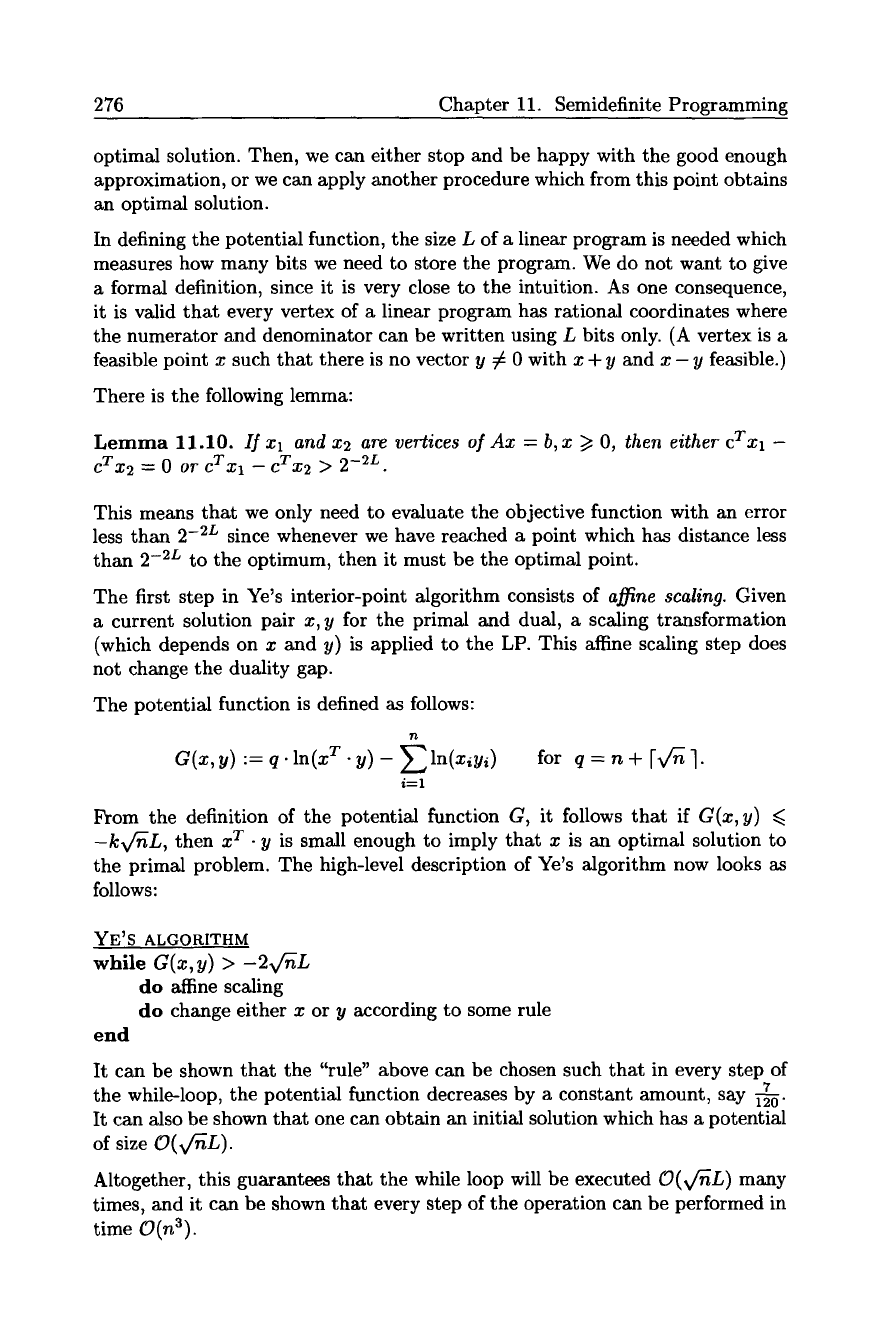
276 Chapter 11. Semidefinite Programming
optimal solution. Then, we can either stop and be happy with the good enough
approximation, or we can apply another procedure which from this point obtains
an optimal solution.
In defining the potential function, the size L of a linear program is needed which
measures how many bits we need to store the program. We do not want to give
a formal definition, since it is very close to the intuition. As one consequence,
it is valid that every vertex of a linear program has rational coordinates where
the numerator and denominator can be written using L bits only. (A vertex is a
feasible point x such that there is no vector y # 0 with x + y and x - y feasible.)
There is the following lemma:
Lemma 11.10. I] Xl and x2 are vertices o] Ax = b,x >/O, then either
cTxl --
cTx2 = 0 or cTxl -- cTx2 > 2 -2L.
This means that we only need to evaluate the objective function with an error
less than 2 -25 since whenever we have reached a point which has distance less
than 2 -2L to the optimum, then it must be the optimal point.
The first step in Ye's interior-point algorithm consists of affine scaling. Given
a current solution pair x, y for the primal and dual, a scaling transformation
(which depends on x and y) is applied to the LP. This affine scaling step does
not change the duality gap.
The potential function is defined as follows:
n
GCx, y) := q. ln(x T. y)
- Z
lnCxiYi) for q = n +
[V~ ].
i=I
From the definition of the potential function G, it follows that if G(x, y) <<.
-kv~L , then x T 9 y is small enough to imply that x is an optimal solution to
the primal problem. The high-level description of Ye's algorithm now looks as
follows:
YE'S ALGORITHM
while G(x, y) > -2vfnL
do affine scaling
do change either x or y according to some rule
end
It can be shown that the "rule" above can be chosen such that in every step of
the while-loop, the potential function decreases by a constant amount, say 12-~6"
It can also be shown that one can obtain an initial solution which has a potential
of size O(x/'nL).
Altogether, this guarantees that the while loop will be executed O(~/-dL) many
times, and it can be shown that every step of the operation can be performed in
time O(n3).
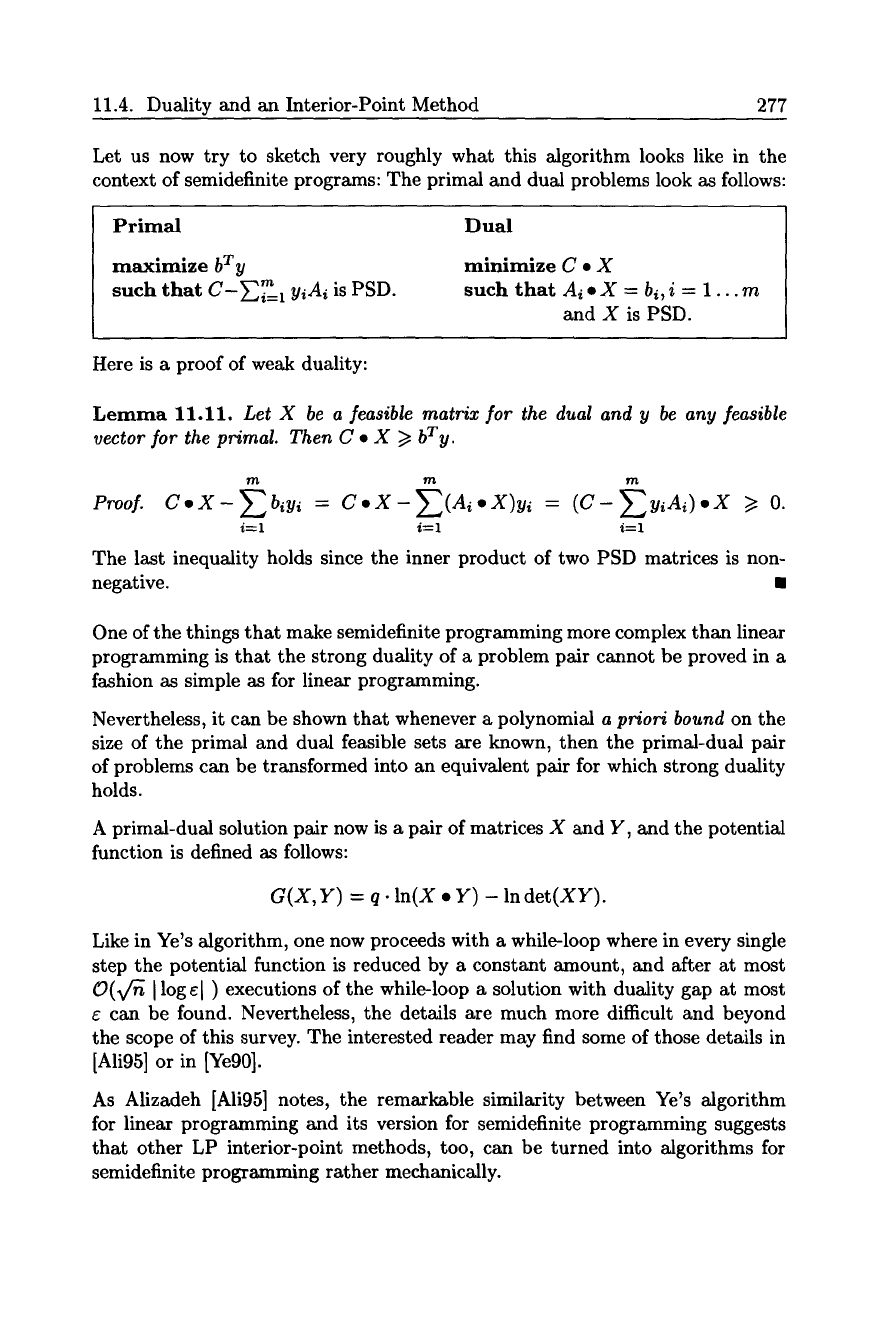
11.4. Duality and an Interior-Point Method 277
Let us now try to sketch very roughly what this algorithm looks like in the
context of semidefinite programs: The primal and dual problems look as follows:
Primal
maximize
bT y
m A
such that
C-~i=l yi i
is PSD.
Dual
minimize C * X
such that
A~ * X = bi, i = 1. . . m
and X is PSD.
Here is a proof of weak duality:
Lemma
11.11.
Let X be a :feasible matrix ]or the dual and y be any/easible
vector for the primal. Then C * X >1 bTy.
?T~ m m
P oi C.X- b,y, = C.X-Z(A,.x)y,
= 0
i-~l i----1
i=l
The last inequality holds since the inner product of two PSD matrices is non-
negative. 9
One of the things that make semidefinite programming more complex than linear
programming is that the strong duality of a problem pair cannot be proved in a
fashion as simple as for linear programming.
Nevertheless, it can be shown that whenever a polynomial
a priori bound
on the
size of the primal and dual feasible sets are known, then the primal-dual pair
of problems can be transformed into an equivalent pair for which strong duality
holds.
A primal-dual solution pair now is a pair of matrices X and Y, and the potential
function is defined as follows:
G(X, Y) = q.
In(X 9 Y) - In det(XY).
Like in Ye's algorithm, one now proceeds with a while-loop where in every single
step the potential function is reduced by a constant amount, and after at most
O(x/~ flog el ) executions of the while-loop a solution with duality gap at most
E can be found. Nevertheless, the details are much more difficult and beyond
the scope of this survey. The interested reader may find some of those details in
[Ali95] or in [Ye90].
As Alizadeh [Aii95] notes, the remarkable similarity between Ye's algorithm
for linear programming and its version for semidefinite programming suggests
that other LP interior-point methods, too, can be turned into algorithms for
semidefinite programming rather mechanically.
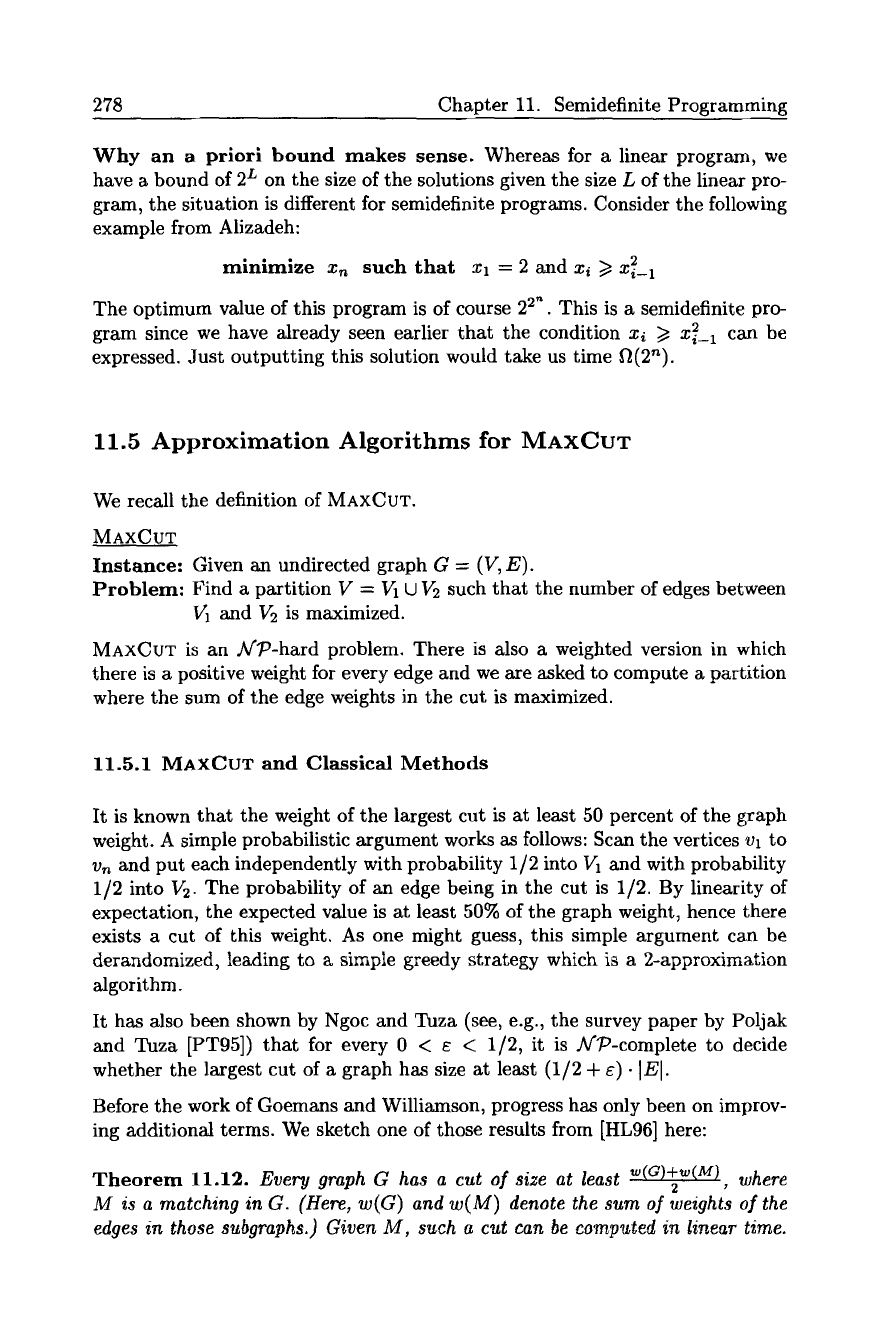
278 Chapter 11. Semidefinite Programming
Why an a priori bound
makes sense.
Whereas for a linear program, we
have a bound of 2 L on the size of the solutions given the size L of the linear pro-
gram, the situation is different for semidefinite programs. Consider the following
example from Alizadeh:
minimize xn such that xl = 2 and xi >/x 2
i--1
The optimum value of this program is of course 22" . This is a semidefinite pro-
gram since we have already seen earlier that the condition x~ >/ 2 x~_ 1 can be
expressed. Just outputting this solution would take us time ~(2n).
11.5 Approximation Algorithms for MAXCUT
We recall the definition of MAXCUT.
MAXCUT
Instance:
Given an undirected graph G = (V, E).
Problem: Find a partition V -- V1 t.J V2 such that the number of edges between
V1 and V2 is maximized.
MAxCUT is an Alp-hard problem. There is also a weighted version in which
there is a positive weight for every edge and we are asked to compute a partition
where the sum of the edge weights in the cut is maximized.
11.5.1 MAXCUT
and Classical
Methods
It is known that the weight of the largest cut is at least 50 percent of the graph
weight. A simple probabilistic argument works as follows: Scan the vertices vl to
vn and put each independently with probability 1/2 into V1 and with probability
1/2 into V2. The probability of an edge being in the cut is 1/2. By linearity of
expectation, the expected value is at least 50% of the graph weight, hence there
exists a cut of this weight. As one might guess, this simple argument can be
derandomized, leading to a simple greedy strategy which is a 2-approximation
algorithm.
It has also been shown by Ngoc and Tuza (see, e.g., the survey paper by Poljak
and Tuza [PT95]) that for every 0 < ~ < 1/2, it is Af:P-complete to decide
whether the largest cut of a graph has size at least (1/2 + e) 9 ]E].
Before the work of Goemans and Williamson, progress has only been on improv-
ing additional terms. We sketch one of those results from [HL96] here:
Theorem 11.12.
Every graph G has a cut of size at least w(a)+w(M) where
2
M is a matching in G. (Here, w(G) and w(M) denote the sum of weights o] the
edges in those subgraphs.) Given M, such a cut can be computed m linear time.
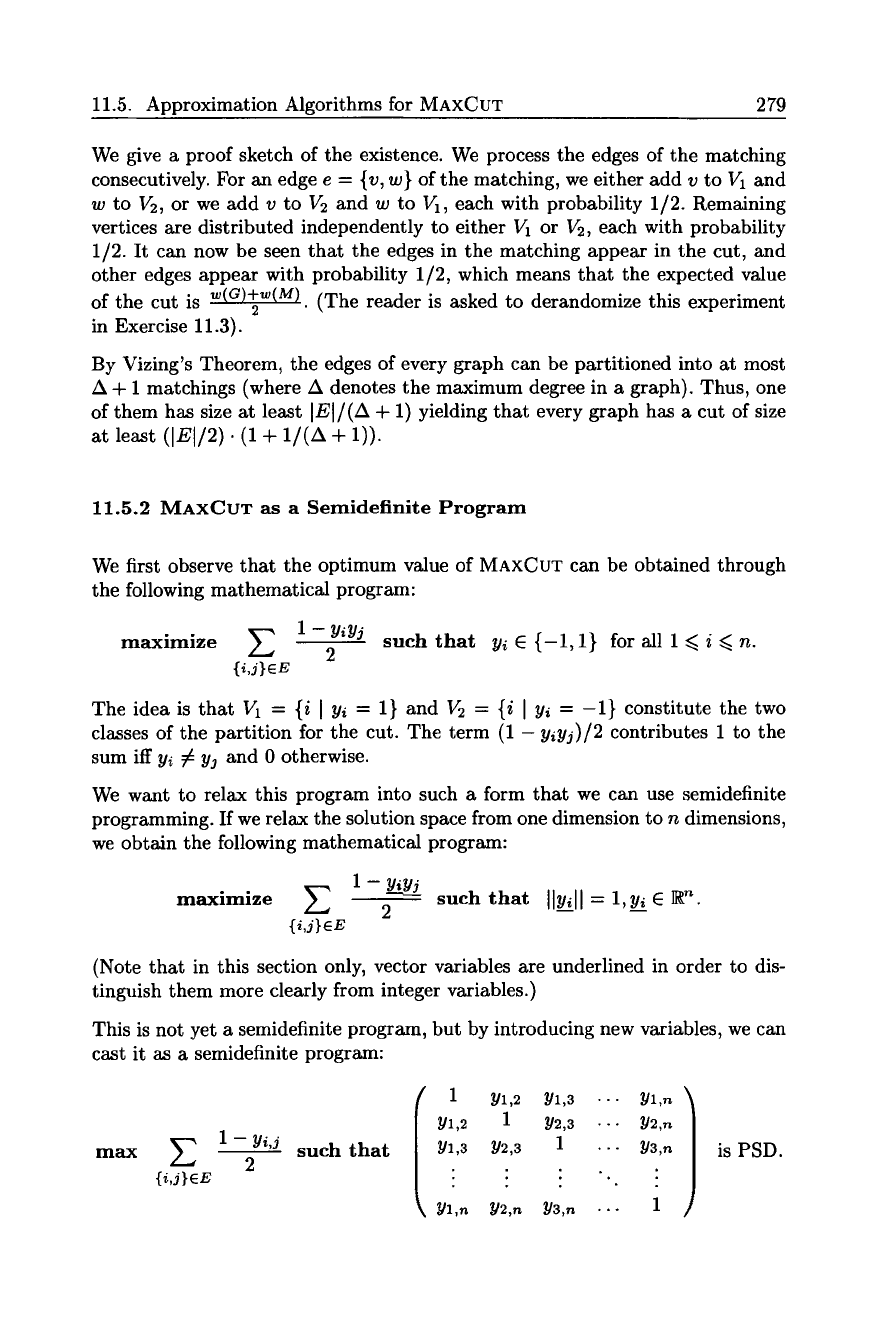
11.5. Approximation Algorithms for MAXCUT 279
We give a proof sketch of the existence. We process the edges of the matching
consecutively. For an edge e -- {v, w} of the matching, we either add v to ]/1 and
w to V2, or we add v to V2 and w to V1, each with probability 1/2. Remaining
vertices are distributed independently to either V1 or V2, each with probability
1/2. It can now be seen that the edges in the matching appear in the cut, and
other edges appear with probability 1/2, which means that the expected value
of the cut is w(G)+w(M) (The reader is asked to derandomize this experiment
2
in Exercise 11.3).
By Vizing's Theorem, the edges of every graph can be partitioned into at most
A + 1 matchings (where A denotes the maximum degree in a graph). Thus, one
of them has size at least
IEI/(A +
1) yielding that every graph has a cut of size
at least (IEI/2) 9 (1 + 1/(A + 1)).
11.5.2 MAxCUT as a Semidefinite
Program
We first observe that the optimum value of MAXCUT can be obtained through
the following mathematical program:
maximize E 1 --
YiYj
such that Yi 9 {-1,1} for all 1 ~ i ~ n.
2
{i,j}eE
The idea is that
V1 = {i [ Yi =
1} and
V2 = {i [ Yi =
-1} constitute the two
classes of the partition for the cut. The term (1 -
yiyj)/2
contributes 1 to the
sum iff
Yi ~ Y3
and 0 otherwise.
We want to relax this program into such a form that we can use semidefinite
programming. If we relax the solution space from one dimension to n dimensions,
we obtain the following mathematical program:
maximize E 1 -YiY__~j such that
Ily ll
= 1,yi 9 ]~n.
2 -- --
{i,j}eE
(Note that in this section only, vector variables are underlined in order to dis-
tinguish them more clearly from integer variables.)
This is not yet a semidefinite program, but by introducing new variables, we can
cast it as a semidefinite program:
max ~ 1-yi,j
such that
2
{i,j)eE
1 yl,2 Yl,3 ... Yl,n
Yl,2 1 Y2,3
.-.
Y2,n
J
Yl,3
Y2,3 1 9 .- Y3,n
. . . -.. 9
Yl,n Y2,n Y3,n ... 1
is PSD.
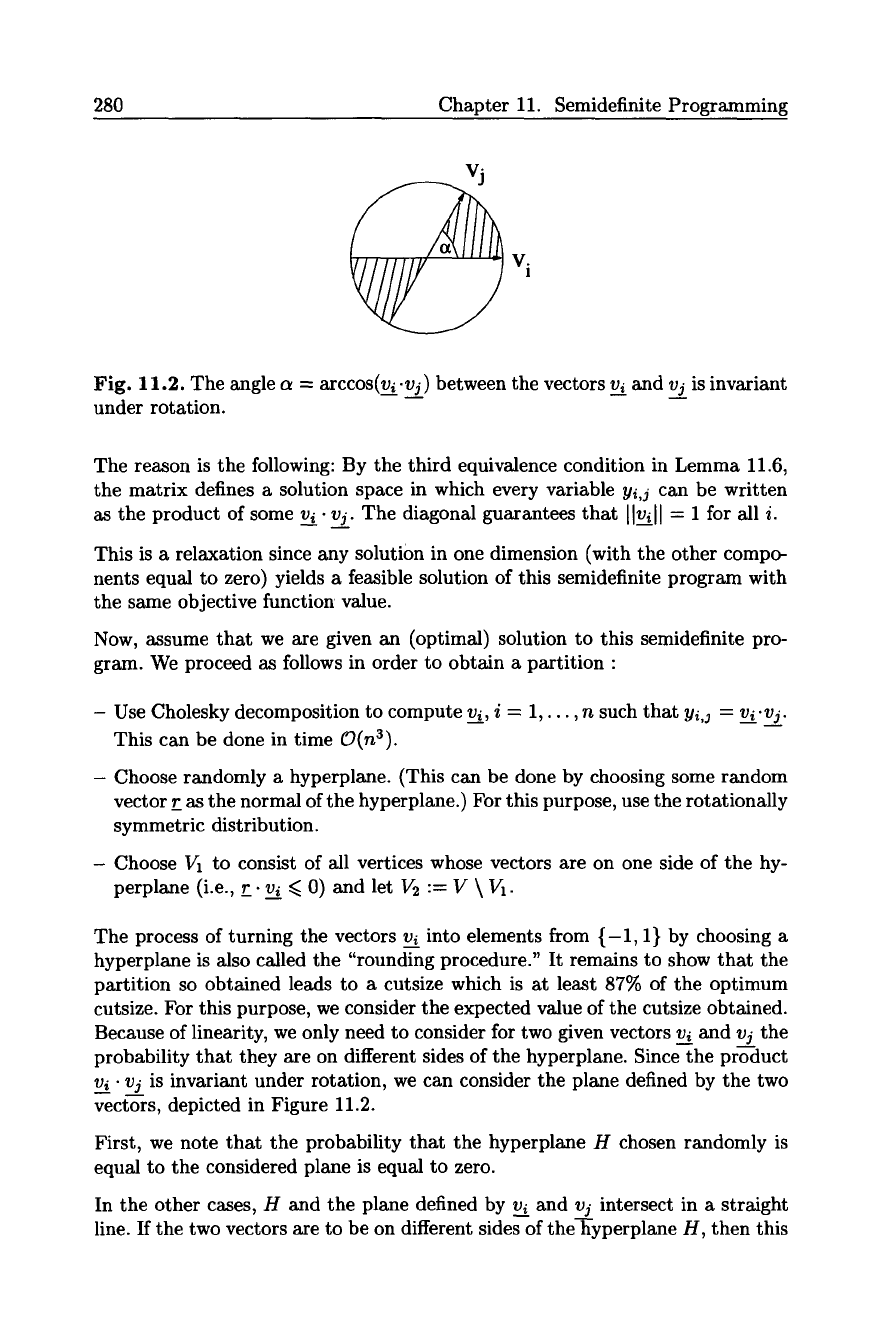
280 Chapter 11. Semidefinite Programming
~r~" Vi
Fig. 11.2. The angle a = arccos(v~, v_Aj) between the vectors v_A and v_A j is invariant
under rotation.
The reason is the following: By the third equivalence condition in Lemma 11.6,
the matrix defines a solution space in which every variable
yi,j
can be written
as the product of some vi. v j. The diagonal guarantees that [1~11 = 1 for all i.
This is a relaxation since any solution in one dimension (with the other compo-
nents equal to zero) yields a feasible solution of this semidefinite program with
the same objective function value.
Now, assume that we are given an (optimal) solution to this semidefinite pro-
gram. We proceed as follows in order to obtain a partition :
- Use Cholesky decomposition to compute ~, i = 1,..., n such that
yi,~ = vi'v_A.
This can be done in time O(n3).
- Choose randomly a hyperplane. (This can be done by choosing some random
vector r as the normal of the hyperplane.) For this purpose, use the rotationally
symmetric distribution.
- Choose Vx to consist of all vertices whose vectors are on one side of the hy-
perplane (i.e., r_. v_i <~ 0) and let V2 := V \ V1.
The process of turning the vectors v~ into elements from {-1, 1} by choosing a
hyperplane is also called the "rounding procedure." It remains to show that the
partition so obtained leads to a cutsize which is at least 87% of the optimum
cutsize. For this purpose, we consider the expected value of the cutsize obtained.
Because of linearity, we only need to consider for two given vectors v_i and vj the
probability that they are on different sides of the hyperplane. Since the product
vA. v~ is invariant under rotation, we can consider the plane defined by the two
vectors, depicted in Figure 11.2.
First, we note that the probability that the hyperplane H chosen randomly is
equal to the considered plane is equal to zero.
In the other cases, H and the plane defined by v i and vr intersect in a straight
line. If the two vectors are to be on different sides of the-~yperplane H, then this
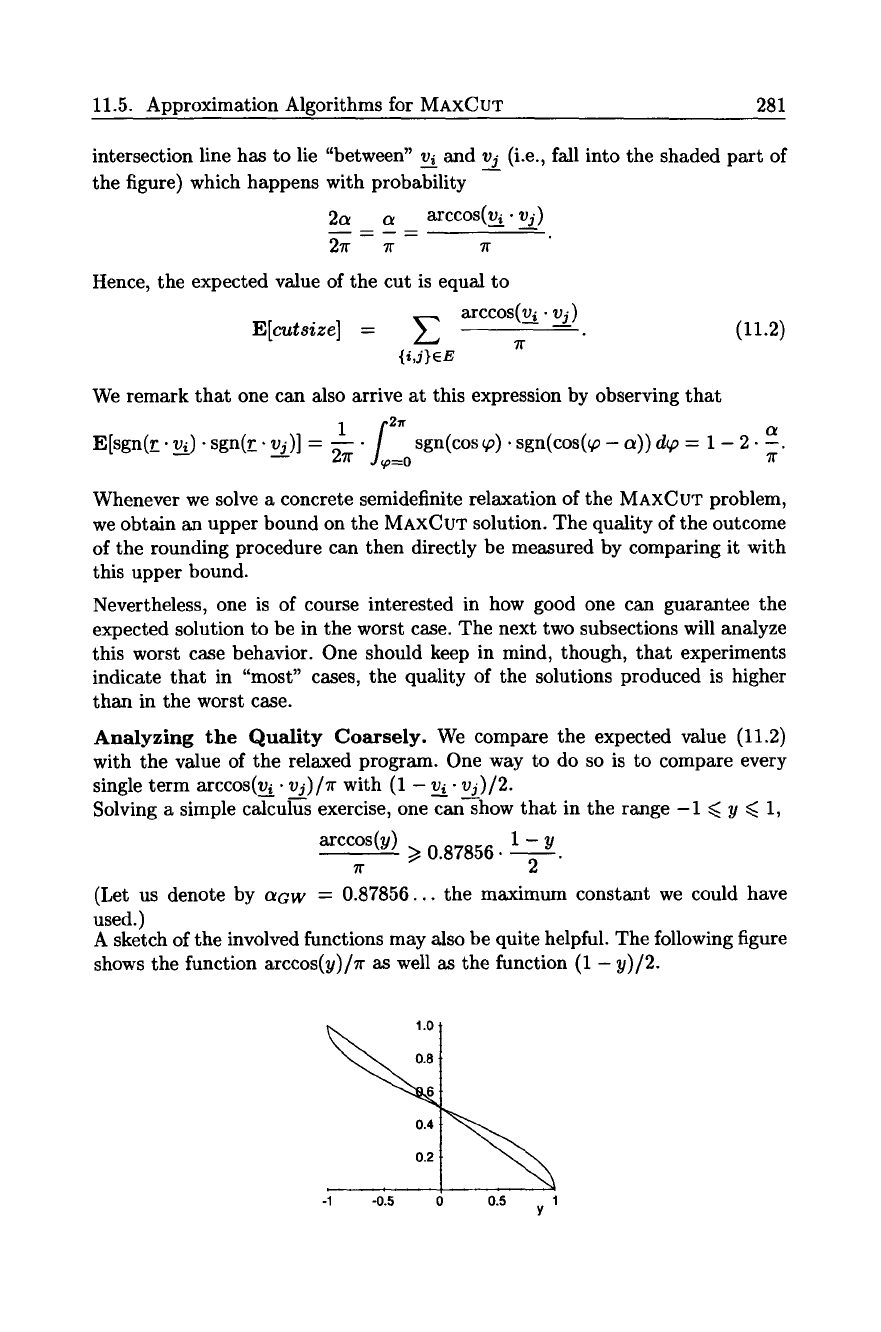
11.5. Approximation Algorithms for MAXCUT 281
intersection line has to lie "between" v_~ and v_A j (i.e., fall into the shaded part of
the figure) which happens with probability
2a a arccos(~.v__~)
2~ ~r r
Hence, the expected value of the cut is equal to
ar cc~ vA " v-AJ )
(11.2)
E[cutsize]
= Z
{i,i}eE
We remark that one can also arrive at this expression by observing that
1If
__
9 sgn(cos ~o). sgn(cos(~o
-
a)) d~o = 1
-
2- a
E[sgn(~.~)- sgn(~, vj)] = ~ =0
~"
Whenever we solve a concrete semidefinite relaxation of the MAXCUT problem,
we obtain an upper bound on the MAxCUT solution. The quality of the outcome
of the rounding procedure can then directly be measured by comparing it with
this upper bound.
Nevertheless, one is of course interested in how good one can guarantee the
expected solution to be in the worst case. The next two subsections will analyze
this worst case behavior. One should keep in mind, though, that experiments
indicate that in "most" cases, the quality of the solutions produced is higher
than in the worst ease.
Analyzing the Quality Coarsely. We compare the expected value (11.2)
with the value of the relaxed program. One way to do so is to compare every
single term arccos(vi 9
vj)/lr
with (1
- v_A. vj)/2.
Solving a simple calculu--s exercise, one can~how that in the range -1 ~< y ~< 1,
arccos(y) 1 - y
>/0.87856. --
2
(Let us denote by
aow
= 0.87856... the maximum constant we could have
used.)
A sketch of the involved functions may also be quite helpful. The following figure
shows the function arccos(y)/lr as well as the function (1 -
y)/2.
1.0
0.4
0.2
-i 4.5 o
0.5 1
Y
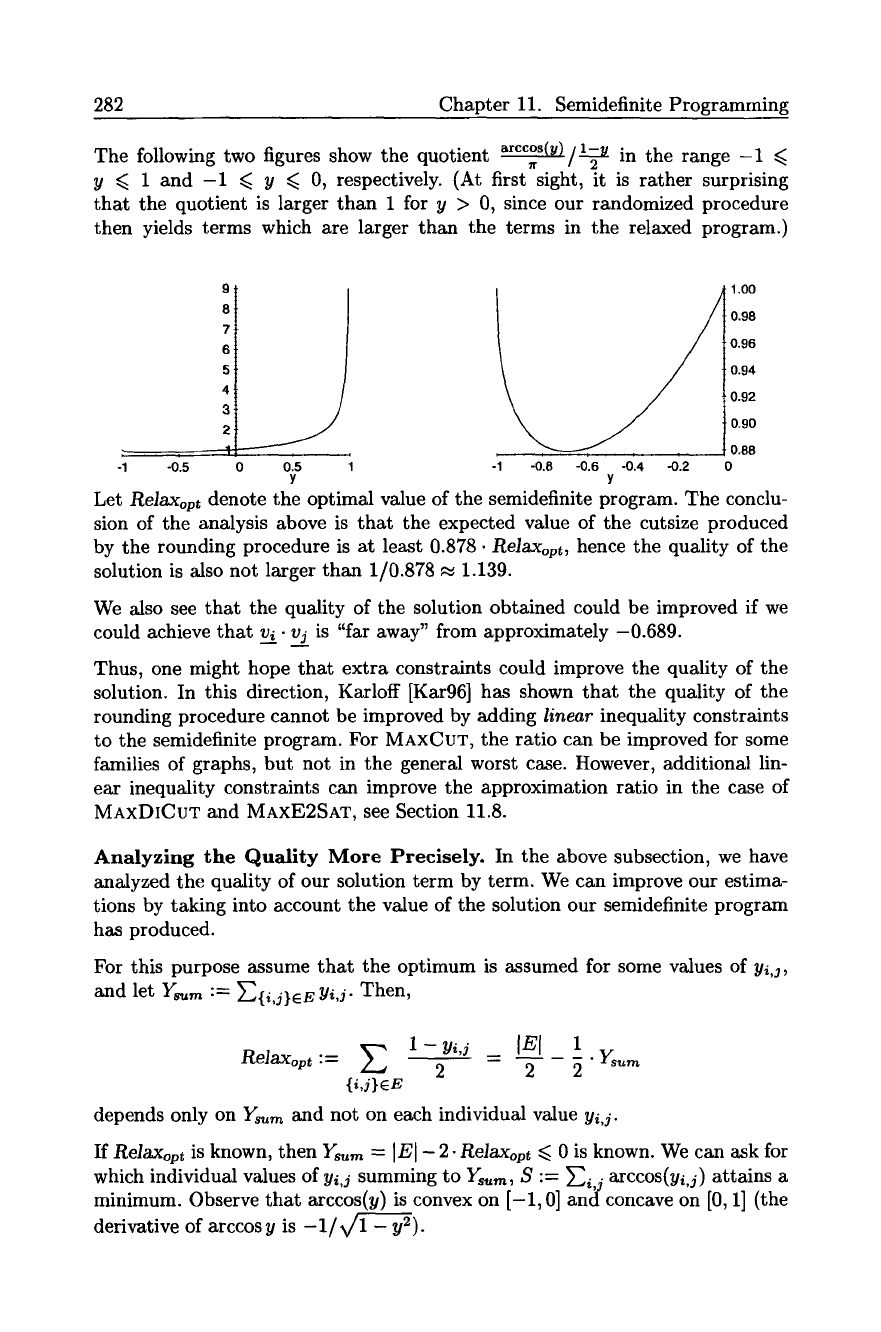
282 Chapter 11. Semidefinite Programming
The following two figures show the quotient arccos(u)~/~ in the range -1
y ~ 1 and -1 ~ y ~ 0, respectively. (At first sight, it is rather surprising
that the quotient is larger than 1 for y > 0, since our randomized procedure
then yields terms which are larger than the terms in the relaxed program.)
8 0.98
7
6 0.96
5 0.94
4 ' 0.92
3
2
:
0.90
;" 1 0.88
-1 -o'.5 o o.s i -1 -o.8 -o.6 -o.4 -o.2 o
Y Y
Let
ReJaxopt
denote the optimal value of the semidefinite program. The conclu-
sion of the analysis above is that the expected value of the cutsize produced
by the rounding procedure is at least 0.878 9 Relaxopt, hence the quality of the
solution is also not larger than 1/0.878 ~ 1.139.
We also see that the quality of the solution obtained could be improved if we
could achieve that vA- v_g j is "far away" from approximately -0.689.
Thus, one might hope that extra constraints could improve the quality of the
solution. In this direction, Karloff [Kar96] has shown that the quality of the
rounding procedure cannot be improved by adding
linear
inequality constraints
to the semidefinite program. For MAXCUT, the ratio can be improved for some
families of graphs, but not in the general worst case. However, additional lin-
ear inequality constraints can improve the approximation ratio in the case of
MAxDICUT and MAXE2SAT, see Section 11.8.
Analyzing the Quality More Precisely. In the above subsection, we have
analyzed the quality of our solution term by term. We can improve our estima-
tions by taking into account the value of the solution our semidefinite program
has produced.
For this purpose assume that the optimum is assumed for some values of Yi,3,
and let Y~,m := ~{~,j}eE
Yid"
Then,
Relaxop,
:= ~ 1 - yi,~ IEI 1
2 = ~- - ~ "Y~
{i,j}eE
depends only on
Ysum
and not on each individual value
yi,j.
If
Relaxopt
is known, then
Ysum =
]El - 2-
Relaxopt <. 0
is known. We can ask for
which individual values of
Yi,j
summing to
Y~,m, S := ~i,j
arcc~ attains a
minimum. Observe that arccos(y) is convex on [-1, 0] and concave on [0, 1] (the
derivative of arccosy is -1/~/1 - y2).

11.5. Approximation Algorithms for MAXCUT 283
In Exercise 11.4, we ask the reader to verify the following: If
Ysum
is fixed,
then the yi,j for which
~'~i,j
arccos(yij) attains a minimum, fulfill the following
property:
There is a value Y ~< 0 and an r with
IE[/2 ~ r <~
[E[ such that r of the
Yi,j
are
equal to Y and IE[ - r of the
yi,j are
equal to one.
Then,
~,{i,j}eE
arcc~ = r- arccos(Y~ ~ IEl+r) and the quotient
52~,.~) arccos(y,.j) can be estimated. We obtain that
Re|aXopt
E[cutsize] >i min r. arccos(~"rlEl+r )
ReIaxopt [g[/2<~ r<~lE [ 7r . Relaxopt
r -- 2.Relaxov~
= min arccos( r )
r 7r. Relaxopt/r
arccos(1 - 2x)
= =:
q(x),
T''X
where we have substituted x :=
Relaxopt/r
for the r where the minimum is
attained. We have obtained the following: Given a graph G with optimal cut-
size
MC, and "relative"
cutsize y :=
MC/IEh
it holds that y ~ x and thus
the "rounding quality"
E[cutsize]/Relaxopt
obtained for graph G is at least
min~>~
q(x).
Below, we give a plot of
Q(y)
:= minx~>y
q(x).
1.00
0.98
0.96
0.94
0.92
0.90
0.88
0.5 0.6 0.7 0.8 0.9 1.0
As we can see, the quality of the rounding procedure becomes better when the
relative maximum cutsize of the input graph becomes larger.
The above analysis only considers the quality of the rounding procedure. Karloff
has shown in [Kar96] that there is a family of graphs for which the quality of
the rounding procedure is arbitrarily close to
aaw.
Nevertheless, it might be
possible to obtain a better approximation ratio than
1/aaw ~
1.139 by using
a different rounding procedure, since for the family of graphs constructed by
Karloff, the optimum cutsize is equal to
Relaxopt.
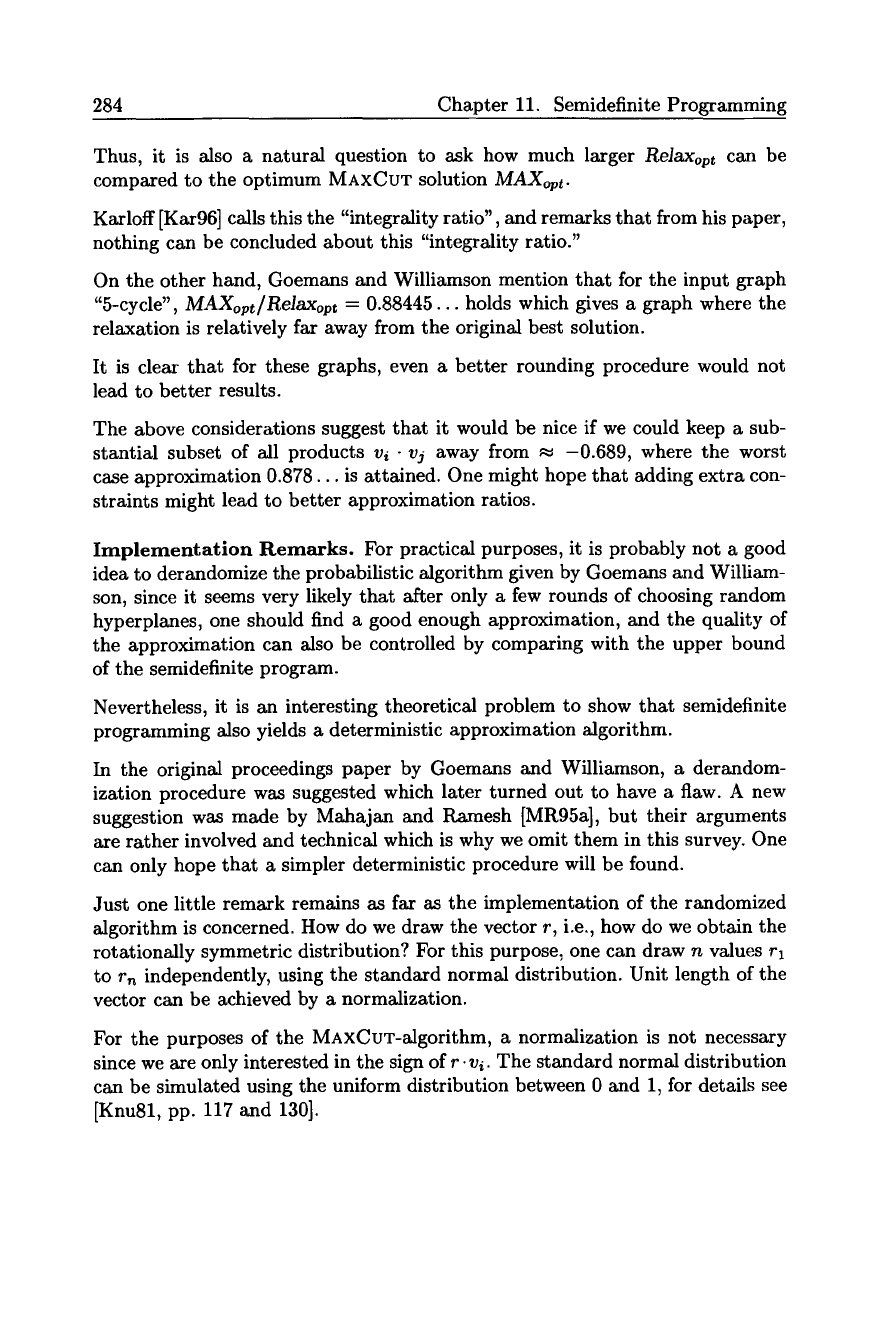
284 Chapter 11. Semidefinite Programming
Thus, it is also a natural question to ask how much larger
Relaxopt
can be
compared to the optimum MAXCUT solution
MAXopt.
Karloff [Kar96] calls this the "integrality ratio", and remarks that from his paper,
nothing can be concluded about this "integrality ratio."
On the other hand, Goemans and Williamson mention that for the input graph
"5-cycle",
MAXopt/Relaxopt =
0.88445... holds which gives a graph where the
relaxation is relatively far away from the original best solution.
It is clear that for these graphs, even a better rounding procedure would not
lead to better results.
The above considerations suggest that it would be nice if we could keep a sub-
stantial subset of all products vi - vj away from ~ -0.689, where the worst
case approximation 0.878... is attained. One might hope that adding extra con-
straints might lead to better approximation ratios.
Implementation Remarks. For practical purposes, it is probably not a good
idea to derandomize the probabilistic algorithm given by Goemans and William-
son, since it seems very likely that after only a few rounds of choosing random
hyperplanes, one should find a good enough approximation, and the quality of
the approximation can also be controlled by comparing with the upper bound
of the semidefinite program.
Nevertheless, it is an interesting theoretical problem to show that semidefinite
programming also yields a deterministic approximation algorithm.
In the original proceedings paper by Goemans and Williamson, a derandom-
ization procedure was suggested which later turned out to have a flaw. A new
suggestion was made by Mahajan and Ramesh [MR95a], but their arguments
are rather involved and technical which is why we omit them in this survey. One
can only hope that a simpler deterministic procedure will be found.
Just one little remark remains as far as the implementation of the randomized
algorithm is concerned. How do we draw the vector r, i.e., how do we obtain the
rotationally symmetric distribution? For this purpose, one can draw n values rl
to
rn
independently, using the standard normal distribution. Unit length of the
vector can be achieved by a normalization.
For the purposes of the MhxCuT-algorithm, a normalization is not necessary
since we are only interested in the sign of
r. vi.
The standard normal distribution
can be simulated using the uniform distribution between 0 and 1, for details see
[Knu81, pp. 117 and 130].
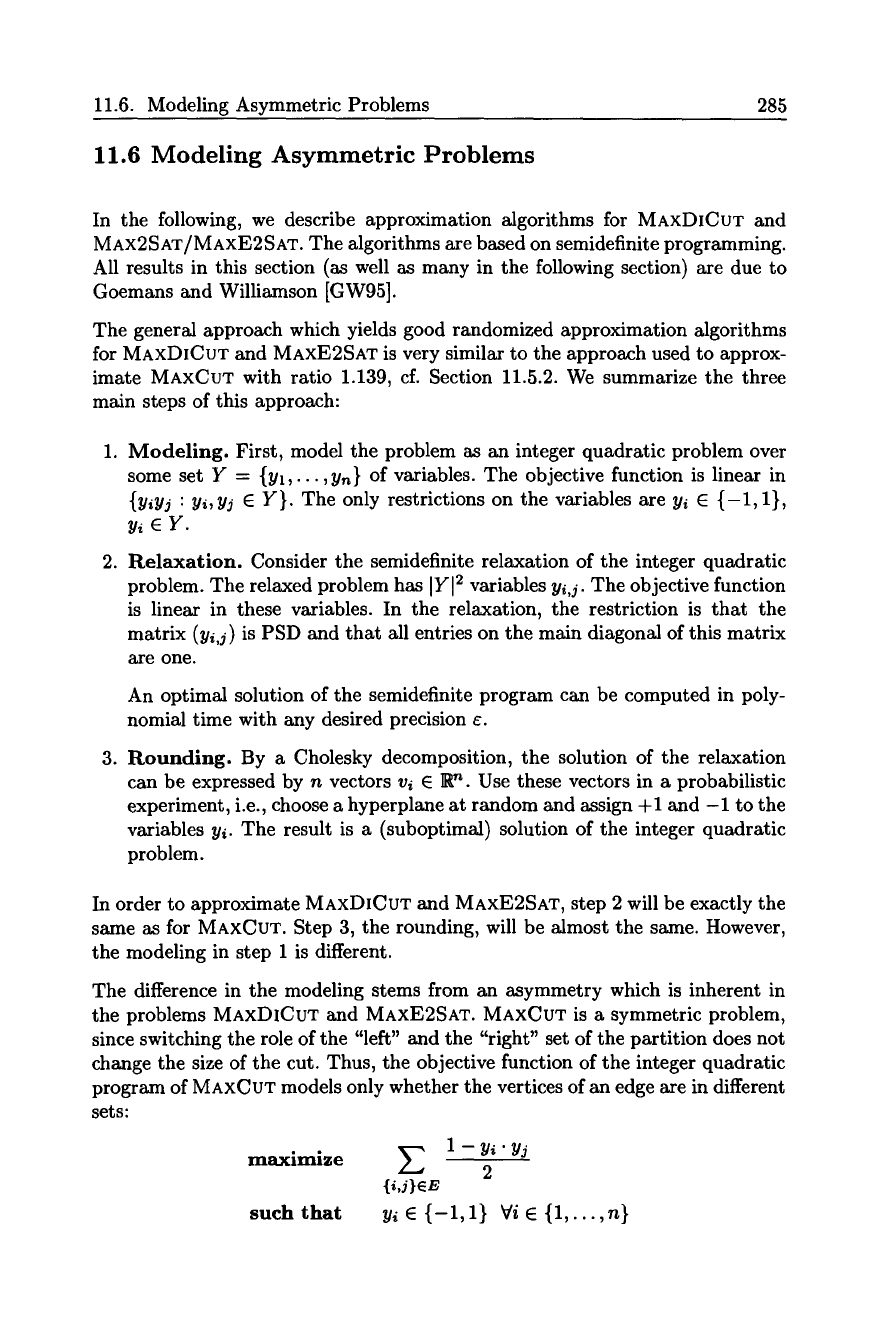
11.6. Modeling Asymmetric Problems 285
11.6 Modeling Asymmetric Problems
In the following, we describe approximation algorithms for MAxDICuT and
MAX2SAT/MAXE2SAT. The algorithms are based on semidefinite programming.
All results in this section (as well as many in the following section) are due to
Goemans and Williamson [GW95].
The general approach which yields good randomized approximation algorithms
for MAxDICUT and MAXE2SAT is very similar to the approach used to approx-
imate MAXCUT with ratio 1.139, cf. Section 11.5.2. We summarize the three
main steps of this approach:
1. Modeling. First, model the problem as an integer quadratic problem over
some set
Y = {Yl,... ,Yn}
of variables. The objective function is linear in
{YiYj : yi,Yj E Y}.
The only restrictions on the variables are
Yi
E {-1, 1},
yiEY.
2. Relaxation. Consider the semidefinite relaxation of the integer quadratic
problem. The relaxed problem has [y[2 variables
Yid.
The objective function
is linear in these variables. In the relaxation, the restriction is that the
matrix
(Yid)
is PSD and that all entries on the main diagonal of this matrix
are one.
An optimal solution of the semidefinite program can be computed in poly-
nomial time with any desired precision ~.
3. Rounding. By a Cholesky decomposition, the solution of the relaxation
can be expressed by n vectors
vi E R n.
Use these vectors in a probabilistic
experiment, i.e., choose a hyperplane at random and assign +1 and -1 to the
variables Yi. The result is a (suboptimal) solution of the integer quadratic
problem.
In order to approximate MhxDICUT and MAXE2SAT, step 2 will be exactly the
same as for MAXCUT. Step 3, the rounding, will be almost the same. However,
the modeling in step 1 is different.
The difference in the modeling stems from an asymmetry which is inherent in
the problems MAXDICUT and MhxE2SAT. MAXCUT is a symmetric problem,
since switching the role of the "left" and the "right" set of the partition does not
change the size of the cut. Thus, the objective function of the integer quadratic
program of MAXCUT models only whether the vertices of an edge are in different
set s:
X-" 1-yi.yj
maximize
2
such
that
Yi e
{-1, 1} Vi G {1,...,n}
